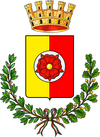Clusone
| Clusone | ||
|---|---|---|

|
|
|
| Country | Italy | |
| region | Lombardy | |
| province | Bergamo (BG) | |
| Local name | Clüsù | |
| Coordinates | 45 ° 53 ' N , 9 ° 57' E | |
| height | 647 m slm | |
| surface | 25 km² | |
| Residents | 8,657 (Dec 31, 2019) | |
| Population density | 346 inhabitants / km² | |
| Post Code | 24023 | |
| prefix | 0346 | |
| ISTAT number | 016077 | |
| Popular name | Clusonesi | |
| Patron saint | San Giovanni Battista | |
| Website | comune.clusone.bg.it | |
Clusone ( Lombard Clüsù ) is an Italian commune ( comune ) with 8,657 inhabitants (as of December 31, 2019) in the province of Bergamo , Lombardy region .
geography
The place is about 35 km northeast of the provincial capital Bergamo at an altitude of 647 m slm Clusone is counted to the upper Val Seriana, although the place is orographically seen to the left above the valley through which the Serio flows on a plateau , the Altopiano di Clusone . The Clusone plateau is of glacial origin and is partly part of the Oglio catchment area .
The neighboring towns are Gandino , Oltressenda Alta , Parre , Piario , Ponte Nossa , Rovetta and Villa d'Ogna .
history
The area was probably owned by the Orobi, a Celto Ligurian people, around 1300 BC. Has been settled. In the Roman era , the place was an important center of the area and was fortified by the Romans. The current name is possibly derived from the Latin Clausus , which indicates the place surrounded by mountains. Clusone was first mentioned in a document in 774 in a deed of donation from Charlemagne . In the Middle Ages , the fortifications given to monks by Charlemagne developed into a castle with defensive walls and towers. At the end of the 14th century, the Aliprandi aristocratic family from Milan gained influence, and in Clusone they adopted the name Fanzago. Under the Republic of Venice , the place experienced its most important artistic, cultural and economic development. After the Peace of Campo Formio in 1797, Clusone was first part of the Cisalpine Republic and then of the Kingdom of Lombardy-Veneto, which was subordinate to the Habsburgs . During the Cisalpine Republic, Clusone received city rights in 1801 . Under the Kingdom of Italy , Clusone was the capital of the district of the same name in the province of Bergamo.
architecture
The city is best known for two buildings, the late Gothic town hall with a planetary clock made by Pietro Fanzago in 1583 and the Order Church of the Flagellants with the famous dance of death from 1485. The basilica of Santa Maria Assunta rises dominantly on the northern outskirts.
sons and daughters of the town
- Giovanni Lenzei (1626–1690), Baroque composer
- Sergio Alfredo Gualberti (* 1945), Archbishop of Santa Cruz de la Sierra
- Sara Dossena (* 1984), duathlete, triathlete and long-distance runner
- Kevin Ceccon (* 1993), racing driver
Attractions
- Oratory dei Disciplini with frescoes
Web links
- Renzo Dionigi: Oratorio dei Disciplini, frescoes on www.flickr.com
- Renzo Dionigi: Oratorio dei Disciplini, frescoes on www.flickr.com
Individual evidence
- ↑ Statistiche demografiche ISTAT. Monthly population statistics of the Istituto Nazionale di Statistica , as of December 31 of 2019.
- ↑ a b Clusone, Lombardia. In: ansa.it. Retrieved April 3, 2020 (Italian).






